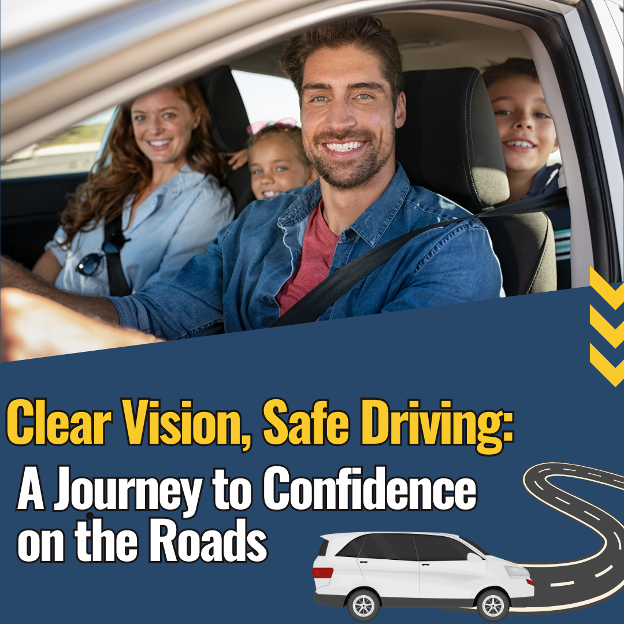Home » Blog » Clear Vision, Safe Driving: A Journey to Confidence on the Roads
Clear Vision, Safe Driving: A Journey to Confidence on the Roads
Posted by: Mitchell Refractive Surgery & Eye Center

There’s nothing quite like the feeling of hitting the open road with confidence, knowing that your vision is as sharp as your focus behind the wheel. Prioritizing clarity not only enhances your driving experience but also ensures safety for you and everyone else on the road. Let’s explore how seeing clearly can make every journey safer and more enjoyable!
Your eyesight is considered the most important of your five senses, so taking good care of your eyes is critical. Good eye health is vital for safe driving, and even a slight adjustment in your eyesight affects how well you can see objects in the distance.
What Are the Visual Functions Necessary for Driving?
Visual Field and visual Acuity are the most critical factors in safe driving. Please check your local laws to determine your vision regulations for driving.
Visual Field – is how wide of an area your eye can see when you focus on a central point. According to the Academy of Ophthalmology, automated perimetry is the most commonly used in the United States, where you watch for flashing lights in a unique device.
Visual Acuity – gauges how clearly you can see and measure by reading letters on an eye chart.
Color Vision – helps to identify brake lights and traffic signals.
Conditions That Can Impact Your Eyesight While Driving
Typical age-related eye changes can affect your eyesight and the ability to drive safely, such as dry eye or presbyopia, which may impact your ability to see the navigation system and reduce the quality of your eyesight at night. Other conditions can affect your vision while driving:
- Glaucoma is a disease that damages your eye’s optic nerve. Often, there are no warning signs or obvious symptoms in the early stages. As the disease progresses, blind spots develop in your peripheral vision or, less commonly, in your central vision.
- Diabetic retinopathy is a disease in which high blood sugar levels damage blood vessels in the retina, stealing both central and peripheral vision.
- A cataract is a progressive clouding of the natural lens inside the eye that causes blurry vision, glare, and halos around lights. Cataracts can also make it harder to see well at night, in bad weather, or in low-light conditions, gradually diminishing color vision.
- Macular degeneration is a disease in which a part of the retina called the macula becomes damaged, causing loss of central vision.
Eye Safety Tips for Driving
Your vision is consistently adapting to your surroundings every minute you are driving. Here are a few safety tips to help you improve your driving safety.
- Keep a pair of sunglasses in your car to be prepared for those bright and sunny days. Be sure that the sunglasses block 100% of UVA and UVB rays. Wearing these types of sunglasses will improve your visual comfort on the road.
- Ensure your windshield and windows are clean inside and out and that your headlights and taillights work correctly to light the road adequately.
- At night, drive more slowly and avoid looking directly into approaching cars’ headlights; look slightly to the right.
- Constantly adjust your mirrors correctly.
- If you suffer from dry eye syndrome, it’s important to consult with your eye doctor. This condition may cause you to experience light scatter, which can lead to glare and difficulty seeing in bright conditions. Managing dry eye syndrome can significantly improve your driving comfort and safety.
Our Goal Is Our Patients’ Lifelong Eye Health
Changes in your vision may be evident for some, while others have a gradual loss of vision that is less noticeable. Keeping your eye exam appointments with your eye doctor will ensure you detect vision changes early and treat conditions promptly before they cause irreversible vision loss. This proactive approach to your eye health is crucial, regardless of age. If you notice any symptoms such as blurry vision, dark spots in your central or peripheral vision, difficulty reading street signs yourself, or a loved one having difficulty, don’t delay making an appointment TODAY with your eye doctor.
Remember, your eye health is in your hands. By following the safety tips and getting regular eye exams, you can Drive Safely and Protect Your Eye Health!

